Functional rehabilitation
As practitioners we are continually dealing with dysfunctional musculoskeletal systems. Typically dysfunction develops and is perpetuated... Read Article
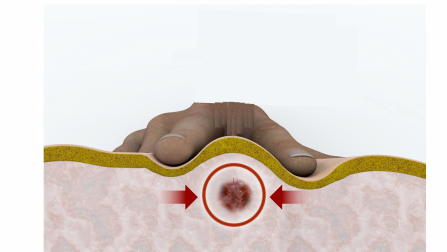
Trigger points are those tender lumps in your muscles that therapists find, and are arguably the biggest cause of musculoskeletal pain syndromes such as back, neck and shoulder pain. In this article we’ll use plain English and simple diagrams to show you:
What trigger points are
The effects trigger points have on your body
What causes trigger points
How common are trigger points
How do you know if you have trigger points
The treatment of trigger points
Professionals
References
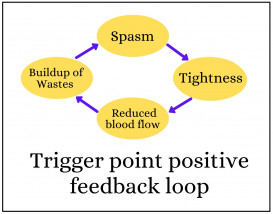
Trigger points are parts of muscles that have gone into spasm or "cramped”. This forms the lump. As shown in this diagram:
This process goes around and around in circles creating what is known as a positive feedback loop. This stops the problem from resolving and causes the lumps to continue to grow (1–5)

Trigger points start small, but because of the positive feedback they gradually grow. As this diagram shows they:
You may read that there are two types of trigger points: latent and active. These are really just the same trigger points.
When a trigger point is aggravated and starts shooting pain it is called “activation”, while the opposite is called “deactivation”.
As an example, it is common for trigger points to hurt when doing an activity and stop hurting when resting. These are swapping between being latent and active. As we will see in the section on treatment trigger points often deactivate (stop hurting) when treated, only to activate again as soon as they are aggravated.
In this section:
The most obvious effect trigger points have on your body is causing pain. They are arguably the biggest cause of musculoskeletal pain syndromes such as back pain, neck pain and shoulder pain, but because trigger points often refer pain elsewhere they can cause seemingly unrelated pain such as headaches or even tooth ache (3,6–21). To show where they shoot pain scientists have developed charts like those below
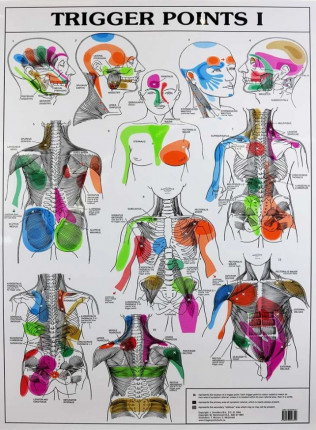
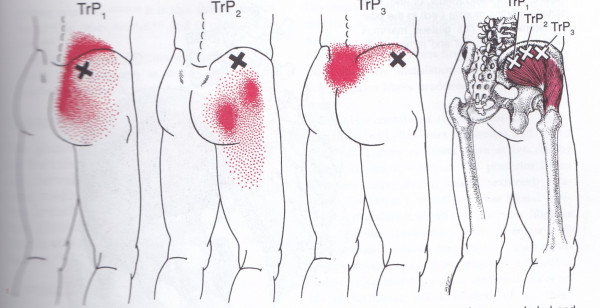
As discussed above, long before trigger points start shooting pain the muscle becomes tightened, blood flow is reduced, and there is a build up of waste products (and reduced nutrients). Therefore even when not hurting trigger points will have the following effects on your body.
The hand drawings
We originally hand drew these diagrams to help explain things in clinic. Patients seemed to understand them so we’ve used them here.
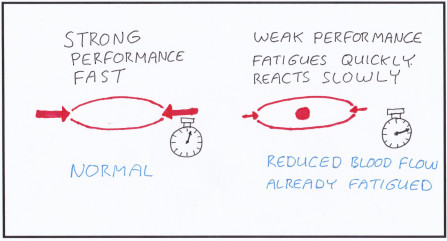
The muscles containing trigger points suffer from poor blood flow, a build up of waste products (and reduced nutrients), and are already fatigued due to the part constantly contracting (spasming). Because of this the muscle will not be as strong and will fatigue quickly. As well, scientists have found that muscles with trigger points are slower to respond to nerve signals from the brain (22) . For more information please see our article article on the effects of (myofascial) trigger points on sports and athletics performance .

When a muscle is tight it is much more likely to tear. There is also abnormal tension where the muscles attach to the bones. The extra tension often causes these attachments to become inflamed and sore. An excellent example is where trigger points in the forearm muscles cause tennis elbow to develop. For more information please see our article Self massage and trigger point therapy for tennis elbow .
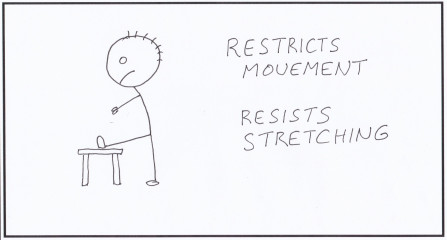
The abnormal tightness in your muscles will also restrict movement generally. As anyone who has tried to stretch a muscle in spasm or cramping will understand, attempting to stretch a muscle containing a trigger point will meet with resistance, and maybe some pain.

Your body maintains an even balanced posture by balancing the tension in the muscles on opposite sides of your body. Having individual muscles tight will alter this balance causing postural changes. In our Chiropractic clinic we would see many people who had been advised to exercise to correct their posture or consciously “straighten up”, when the real issue was tightened muscles due to trigger points.

The joints of your body are designed to “sit nicely balanced”. As shown in this diagram the changes in posture caused by trigger points will alter the alignment of the joints, resulting in increased wear and an increased risk of injury.
When your nervous system is is bombarded with pain for long periods of time it can become sensitised, so any pain becomes much worse. This is what happens in fibromyalgia and other chronic pain syndromes. Because trigger points are often not diagnosed or poorly treated they are a major source of this long term pain. For more information please see: The root cause of fibromyalgia
You may read lists of things that cause trigger points, however the main cause is prolonged abnormal stress or tension in the muscles.

Prolonged tension in the muscles reduces blood flow, which causes a build up of wastes and a reduced amount of nutrients. Tension restricts blood flow by:

Sitting at a desk can often cause your muscles to be tight for long periods of time. Because of this office workers often develop trigger points in their neck and shoulder muscles.
Emotional stress and tension can cause muscles around the head and neck to tighten. The trigger points these cause are a major cause of headaches. For more information please see: Self massage and trigger point therapy for headaches and migraines
As discussed above trigger points cause muscles to tighten. By doing this they make the ideal environment to keep growing and for more trigger points to develop.
Trigger points can go for years or decade before causing pain, then when they do cause pain doctors usually do not diagnose them. Because of this, as the two examples below show most people have large numbers of trigger points.
For why doctors do not diagnose trigger points please see our article The root cause of fibromyalgia .
An investigation of pain free adults found that nearly 90% had trigger points in their shoulder muscles (23).
Office workers and blue collar workers with pain in their neck and shoulder region were checked for trigger points in their neck, shoulder and arm muscles (24). The results were:
It is very easy to examine your muscles and find trigger points yourself. Please check out our video demonstration below.
There are excellent professionals who can help identify trigger points. These include Chiropractors, Osteopaths and suitably qualified therapist. As a warning, medical doctors will usually be unable to help. Trigger points do not show up in standard medical tests, and despite being a major cause of pain and rarely mentioned in medical journals (25,26).
For a complete discussion and advice on how to treat trigger points please see our excellent Trigger point therapy guide or the two videos linked below. However, we will you a quick overview.
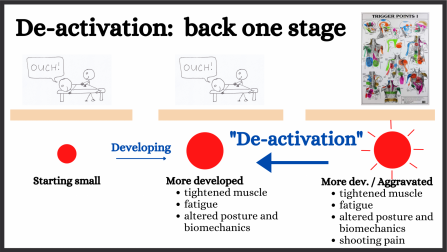
Most courses of trigger point therapy (eg. needles, laser or manual techniques) just stop the trigger points hurting and do not actually eliminate them. As mentioned above this is called “deactivation” and is shown in this diagram. Of course they are still there so they continue to have adverse effects on your body and are eventually re-aggravated and cause pain again. The only way to eliminate them properly is to continue regular treatment long after the pain has gone. To do this we recommend an effective self treatment, otherwise it would be tremendously expensive.

As shown above trigger points are spasm, muscle tightness, restricted blood flow and a build up of waste products all going around in a circle forming what we call a positive feedback loop. Trigger point work on parts of this loop. For example, conventional massage relaxes muscles, stimulates blood flow and helps remove wastes. It works on three parts of this loop so it is an effective therapy.

There is only one trigger point therapy that is easy to do on yourself and is very effective. That is vibration massage where the pad of a therapeutic vibration massager is placed over the trigger points, while as this diagram shows the vibrations penetrate and work on all four parts of the feedback loop. For more information please see our Vibration massage usage guide .
Massage guns do not deliver the therapeutic vibrations needed. This is becuase they are designed to drive their heads into your muscles like a jackhammer rather than send in vibrations. As a result:
For more information please see Do massage guns actually work .
DrGraeme massagers were originally built by Dr Graeme for use in his clinic, and to prescribe to his patients for additional self use at home. Now these are used by colleagues and other professionals for similar purposes. If you are a professional and wish to know more about this therapy, or possibly get a sample massager to trial please check out our practitioner page.
We are continually adding more information on research and uses. Subscribe below to have us email them to you "hot off the press".

Several years ago Dr Graeme, a Chiropractor practicing in Victoria, Australia was looking for a serious hand held massager his patients could use at home to get the extra quality massage they needed. The ones he found in the shops and on-line for home use looked nice but were not serious, and... read more
As practitioners we are continually dealing with dysfunctional musculoskeletal systems. Typically dysfunction develops and is perpetuated... Read Article
Vibration massage has been used by professionals for decades, but more recently personal use machines have made this therapy available... Read Article
Tennis elbow is a painful and disabling condition that is said to develop through overuse, but why does it then refuse to heal and defy... Read Article
When we look at the root cause of fibromyalgia we need to look at two levels: 1. the malfunction of the nervous system which causes the... Read Article
Sports massages are widely used and come with a host of claims such as that they increase performance and help recovery. However, when... Read Article
Do not refresh or leave this page until loading complete.